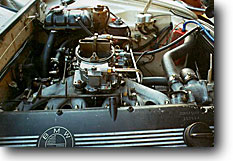| By Larry Klein*
SIMPLE FIX: The Fusible Link
This clock fix is pretty straightforward, but you have to have steady
hands. 99 times out of 100 the problem with these clocks is that
the
fusible link has burned out and it needs to be reconnected. This
is of
course only true with the electro-mechanical clocks, not the quartz
ones
- if the quartz ones go, you might as well toss `em.
The fusible link will blow EVERY TIME if you connect the clock
backwards, EVEN FOR AN INSTANT, so don't do that. The POSITIVE (+)
connection is the one coming out the center of the back, the NEGATIVE
(-) is to the chassis of the clock. That positive power is on ALL
THE
TIME, so if you really want to be sure, pull the clock fuse until
all
the connections are, well, connected.
If connecting it backward wasn't your problem, it's probably really
better to take the whole thing apart and clean it than to just fix
the
fusible link, cos odds are that the clock being dirty caused the
link to
blow. That's not a job for the faint of heart, though, so the first
part here is just for fixing the fusible link.
To fix the link, take the back off the clock - it's held on by three
nuts, one of which is probably inside a small gray plastic case
- a
"factory seal" - if the clock has not been molested before now.
Just
grab the plastic around the nut with a small pliers and squeeze
it - the top
will pop off and you can see the nut inside. I just crack those
things off
and toss them.
With the cover off, you can see the mechanical works, in the midst
of
which will be an electrical coil - look for copper windings. That
coil
is the electromagnet that winds the clock when it runs down - the
spring
in it is good for about 5 minutes, then a set of contacts closes
and
energizes the coil, which pulls the spring back again. At this point
you can figure out which part turns to wind the clock, and you can
turn it a
little and see if the clock starts to run. If it doesn't start on
it's
own just by winding it, then it really needs a cleaning and the
fusible
link fix alone isn't going to work.
Assuming it starts on it's own, and the fusible link is just busted
on one end of the electrical coil, there is a little finger of metal
that is supposed to be held by a rivet onto the chassis of the clock.
You
can probably still see the remains of the rivet, and see where the
finger of metal belongs. This "rivet" is actually made of a
low-temperature solder, so that if for whatever reason the contacts
energizing the coil don't immediately open (clock is stuck, etc.),
the "rivet" melts and the power to the coil is cut off. This is
preferable to starting a fire in your dashboard!
What I do is, rather than try to re-solder the connection (the solder
is
so ridiculously low-temperature that it just runs everywhere if
you try
it with a normal iron), I pull out the remains of the rivet and
carefully re-form it into a new rivet by mashing it this way and
that
with a jeweler's pliers. It's not as difficult as it sounds - except
for it being TINY (the head is about 2.5 mm across), it's just like
straightening a nail. When I have the rivet shaped, I simply put
the
finger of metal back were it belongs (you have to hold it there
- it's
spring-loaded to pull away), line up the holes (you'll know them
when
you see them) and put the rivet through the holes. Then gently mash
the
point down into a headed rivet again, so it doesn't fall out. The
electrical connection is restored! You might clean the electrical
contacts for good measure with alcohol (they get pretty sooty, which
is
what gunkifies the clock in the first place), and put the whole
thing
back together. If you're considering oiling it, I just use a light
oil
(like gun oil) and only lubricate the shafts of the BIG gears, not
the
little oscillating balance wheel; it's jeweled and lubing it just
gunks
it up. Use oil VERY sparingly - like applied with a toothpick.
If you decide take the clock apart to give it a real cleaning, be
prepared to maybe STILL have it not work afterward. It's so delicate
that my success rate (and I have some experience) is about 70%.
A
well-known and S6R-friendly store owner gave me 5 clocks to do for
him,
and including the 3 or 4 I had laying around, I was able to - just
barely - give him back 5 perfect ones. Like the one in my car (which
has been working perfectly for two years now), they worked great
when I was done with them.
The following is not for the faint of heart, weak of eye, or unsteady
of
hand:
Taking the Clock Apart
The first thing you must do, and this is an ABSOLUTE must, is look
at
the clock carefully, figuring out how it works and what is connected
to
what. If you start to take it apart without understanding where
everything goes and why, then getting it back together again will
be NO
pic-a-nic. Diagram if you have to. Understand that the larger gears
are closer to the power source (the spring, not the electrical
connection) and the power in transferred from there through smaller
and
smaller gears leading down to the escape wheel (the plastic gear
with
the funny teeth), balance wheel (the wheel that oscillates back
and
forth) and fulcrum (rides the funny teeth on the escape wheel and
goes
back and forth across the balance wheel).
It sounds really complicated, but there are only 3 gears in the
time
train of the clock. The time train connects the power source to
the
power release - the balance wheel, which lets the power out in even
increments (the ticking), and thus makes the clock accurate. There
are
a couple of other gears that gear down the hour hand so that it
runs at
1/12th the speed of the minute hand, but those are separate and
easy to
deal with.
The nuts that hold the back on screw onto shafts that run through
the
clock from front to back. Remove the setting knob, the screws holding
the front on, remove the hands and face, and remember (or better
yet,
diagram) the arrangement of gears that connect the setting knob
shaft to
the works. It is a pain to get that back together if you have to
figure
it out.
After the face is off, you'll see three spring clips that hold the
works
to the chassis - these have to come off, and they're a b*tch. Don't'
lose them - if you bent them up don't worry about it; straighten
them so
you can use them again.
Next, if you haven't already done so to deal with the fusible link,
on
each shaft where a nut was holding on the back of the clock there
is
another nut that was under the cover (sort of a jam nut situation
before
you took the back off). There are three; removing them will allow
you
to take the electrical assembly in it's entirety off of the clock.
You can also, at this point, pry off the silver-colored pin that
holds
the hand reduction gears together on the other end of the clock.
It's
holding one of the brass gears on the front (behind where the face
was)
on; it just prys off. That will let you take off the hour-hand gear
and
the transfer gear; to get the minute-hand gear off you'll need to
pry up
and rotate the bushing that holds one end of the power gear. The
power
gear is the one that pokes through the top plate and powers these
three
front gears. The bushing in question has a little plastic tab on
it
made specifically for grabbing and lifting so you can rotate is
and free
the minute-hand gear. Don't lose the spring washer under it.
This leaves you with the works in it's bare-bones state - it's pretty
easy now to see how it works.
Taking the rest of the clock apart is fairly obvious - the shafts
that
hold the plates together are threaded on the ends - just grab the
hex at the base of each shaft and turn it.
Obviously, remember where everything goes.
Use alcohol for cleaning - I soaked all the mechanical bits for
awhile.
I DID NOT SOAK THE ELECTRICAL BITS, and I would recommend against
it
(but without any real authority). Of course, be very careful of
the
hairspring - the tiny spring (thickness of a hair) that causes the
balance wheel to oscillate. When you take the clock apart, the balance
wheel will be held on by nothing but that tiny spring, so be careful.
I, as a rule, do not take apart the hairspring or fiddle with the
tightness of the balance wheel (the adjustment screw has lock-tite
on
it, and I leave it) because I don't have instruments or data for
getting>
that stuff back in tune.
Assembly is the reverse of dismantling - with the following note:
the
shaft that regulates the speed of the clock (a shaft that rides
against
a half-moon-shaped plate), does not go in until last - the spring
that retains it goes in before it. Position the spring (it looks
like a
little clip) in the pocket where it resides, then push the setting
shaft
in until it snaps into place - the spring causes the groove in the
shaft
to engage the half-moon plate. Also, remember when putting the
electrical assembly back in place (on the back of the works) to
hold the
spring-loaded pall out of the way of the ratchet gear (the pall
lets the
gear only turn in one direction, so you can wind the clock). You
saw
how that worked when you wound the clock before you started all
this
nonsense.
If none of this makes sense, you obviously aren't in the middle
of a
tear-down, and perhaps you don't want to be.
If you've done everything right, not overdone it with the oil, and
haven't damaged any of the itty-bitty critical parts while going
through
all this nonsense, the clock should run when you manually wind it.
Every time. Starting by itself (though sometimes I've had to give
it a
shake the very first time). When testing it, make sure to let it
run>
completely down a few times, in addition to connecting it to at
least a
2 amp 12v power source to have it self wind.
And, again, DON'T CONNECT IT BACKWARDS!
Hope this has been educational and not too painful. Doing it without
diagrams has been a challenge...
|



